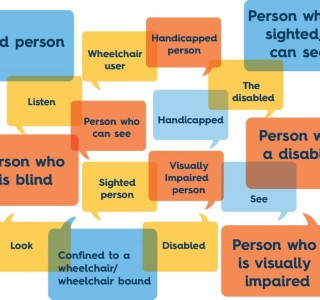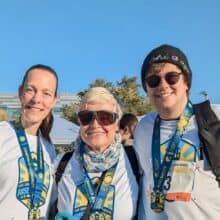
Language Matters: Tips for Talking and Writing about Blindness and Other Disabilities
June 23, 2016
Around 54 million, or 19 percent, of people in the United States have a disability. The way in which we talk or write about disabilities and other health conditions has a profound impact on society. Our language can either portray people with disabilities in a positive manner, or continue to reinforce outdated stereotypes. As a person with a disability, I have constantly heard and read inaccurate and even offensive language, both in the media and in public places. These are just a few tips and suggestions on how to refer to and talk about disabilities.
- Only mention a disability or other health condition if it is relevant to the story or conversation. If I’m talking about my summer vacation, my disability most likely should not be part of the conversation. On the other hand, if a reporter is doing a story on how a person adapts to his or her disability, then it is perfectly acceptable to discuss it.
- Many disability advocates promote the use of person first language. Instead of referring to someone who can’t see as “the blind person,” it is considered more appropriate to say “the person who is blind.” To me, the rule of thumb is to ask the person with a disability for their preference. I, for example, don’t mind when someone refers to me as a “blind person.” If you are unsure, it is better to use person first language.
- Do not use terms like “crippled,” “handicapped,” “invalid,” “confined to a wheelchair,” “wheelchair-bound” or “retarded.” These terms are considered offensive and outdated by many people. On the other hand, people with disabilities occasionally still use them among themselves, and this is considered acceptable.
- Do not use phrases like “victim,” “suffers from,” “stricken with,” “in spite of,” “poor,” “helpless,” “abnormal/normal,” “sick/healthy,” “differently abled,” “inspirational,” “brave,” “special” or “courageous.” This terminology reinforces negative or misleading stereotypes about people with disabilities.
- When referring to a person who is not disabled, it is perfectly okay to say things like “non-disabled person” or “person without a disability.” Similarly, when talking about someone who can see, it is acceptable to say “person who is sighted” or “person with sight.”
- Many of us with disabilities often use humor or joke about our condition. While this is perfectly acceptable, people without disabilities should refrain from saying such jokes because they might be considered offensive.
- It is perfectly okay for you to use words like “see, ” “look” or “watch” when talking with someone who is blind or visually impaired. On the same note, it is acceptable for you to say things like “blind” or “visually impaired” in your conversation.
These are just a few tips for both the media and general public on how to talk about disabilities. People with disabilities are constantly advocating for greater accessibility and equal rights, and by changing our language we can go a far way in redefining how society views disabilities. For more tips and information, visit the Disability Language Style Guide from the National Center on Journalism and Disability. What other tips or suggestions would you add to this list?






